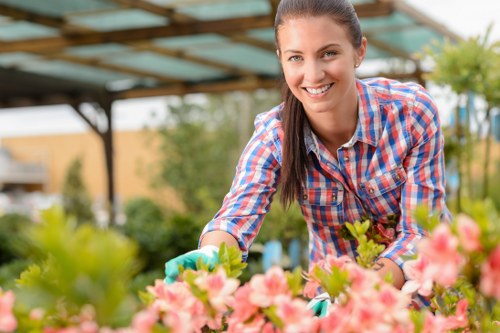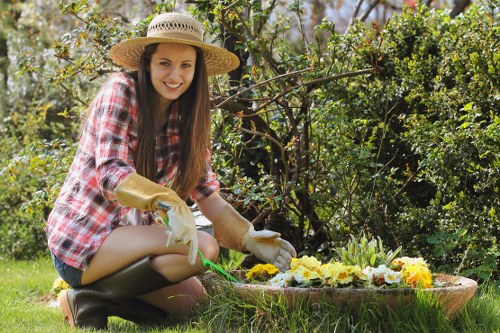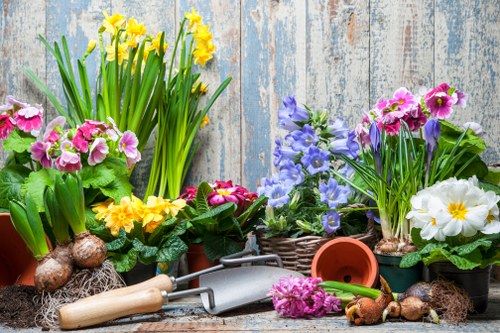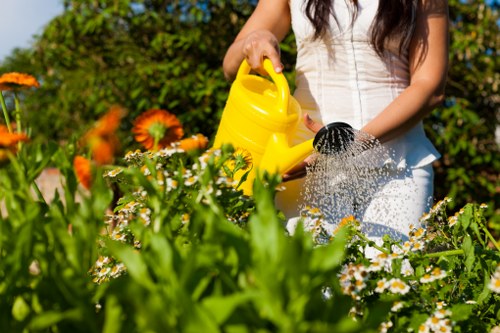Comprehensive Guide to Garden Maintenance in Slade Green

Maintaining a beautiful garden in Slade Green requires dedication, knowledge, and the right tools. Whether you're a seasoned gardener or just starting, understanding the unique aspects of garden care in this area can help you achieve a thriving outdoor space.
Slade Green, with its temperate climate and rich soil, offers an ideal environment for a variety of plants. However, seasonal changes and local pests can pose challenges. This guide covers essential garden maintenance tips tailored specifically for residents of Slade Green.
From selecting the right plants to regular upkeep tasks, we'll explore everything you need to keep your garden healthy and vibrant throughout the year.
Understanding Slade Green's Climate and Soil

The climate in Slade Green is characterized by mild winters and warm summers, providing a conducive environment for diverse plant species. The soil here is predominantly loamy, ensuring good drainage and nutrient retention, which are critical for plant growth.
To optimize your garden's health, it's essential to conduct a soil test. This will help you understand the pH levels and nutrient content, allowing you to amend the soil as needed. Adding compost or organic matter can enhance soil fertility and structure, promoting robust plant development.
Additionally, understanding the microclimates within your garden—such as areas with more shade or sun exposure—can help you place plants in environments where they'll thrive best.
Choosing the Right Plants for Slade Green

Selecting plants that are well-suited to Slade Green's climate and soil conditions is crucial for a low-maintenance garden. Native plants are often the best choice, as they are adapted to the local environment and require less care.
Consider incorporating a mix of perennials, annuals, shrubs, and trees to add variety and structure to your garden. Popular choices in Slade Green include lavender, roses, hydrangeas, and ornamental grasses. These plants not only add beauty but also attract pollinators, enhancing your garden's ecosystem.
For vegetable gardens, leafy greens, root vegetables, and herbs perform well in the local conditions. Ensure you provide adequate spacing and support for plants to grow healthily.
Regular Maintenance Tasks

Maintaining a garden requires consistent effort throughout the year. Here are some essential maintenance tasks:
- Watering: Water your plants early in the morning to reduce evaporation and prevent fungal diseases.
- Weeding: Regularly remove weeds to prevent them from competing with your plants for nutrients and water.
- Pruning: Trim overgrown branches and dead foliage to encourage healthy growth and improve plant shape.
- Fertilizing: Apply fertilizers based on your soil test results to provide necessary nutrients.
- Pest Control: Monitor for pests and diseases, using organic or chemical treatments as appropriate.
Implementing a seasonal maintenance schedule can help you stay on top of these tasks and ensure your garden remains in excellent condition.
Seasonal Gardening Tips

Each season brings its own set of challenges and opportunities for your garden. Here's how to adapt your maintenance practices throughout the year:
Spring
Spring is the time for planting new flowers and vegetables. Prepare your garden beds by clearing debris and enriching the soil. Start seeds indoors or directly sow them outdoors, depending on the plant requirements.
Summer
During the summer, focus on watering, weeding, and pest control. Mulching can help retain moisture and keep weeds at bay. Ensure your plants receive adequate sunlight and are protected from extreme heat.
Autumn
Autumn is ideal for planting trees and shrubs. It's also the time to harvest remaining crops and prepare your garden for the colder months. Clearing fallen leaves and adding compost can enrich the soil for the next planting season.
Winter
In winter, focus on protecting your plants from frost and harsh weather. Prune dormant plants and plan your garden layout for the upcoming year. Using frost blankets or covers can safeguard sensitive plants from temperature drops.
Tools and Equipment for Effective Garden Maintenance
Having the right tools makes garden maintenance more manageable and efficient. Essential tools include:
- Pruning Shears: For trimming and shaping plants.
- Garden Fork: To aerate the soil and remove weeds.
- Hand Trowel: For planting and transferring small plants.
- Watering Can or Hose: To ensure plants receive adequate moisture.
- Gloves: To protect your hands while working in the garden.
Investing in high-quality tools can save time and reduce physical strain, making your garden maintenance tasks more enjoyable.
Local Garden Maintenance Services in Slade Green
For those who prefer professional assistance, Slade Green offers a range of garden maintenance services. Professional gardeners can provide expertise in plant selection, soil management, and landscape design, ensuring your garden looks its best year-round.
Hiring local services also supports the community and ensures that help is familiar with the specific needs and challenges of gardening in Slade Green.
When choosing a garden maintenance service, consider factors such as experience, customer reviews, and the range of services offered to find the best fit for your garden's needs.
Common Gardening Challenges in Slade Green and How to Overcome Them
Gardening in Slade Green comes with its unique set of challenges. Understanding these can help you prepare and mitigate potential issues:
- Pest Infestations: Monitor your garden regularly for signs of pests. Use integrated pest management techniques to control infestations without harming beneficial insects.
- Disease Prevention: Ensure proper spacing and airflow between plants to prevent fungal diseases. Remove and dispose of affected plant parts promptly.
- Weather Extremes: Protect your plants from unexpected weather changes by using covers or relocating sensitive plants to sheltered areas.
- Soil Nutrient Deficiency: Regular soil testing and appropriate fertilization can prevent nutrient deficiencies that hinder plant growth.
By proactively addressing these challenges, you can maintain a healthy and flourishing garden in Slade Green.
Community and Resources for Gardeners in Slade Green
Engaging with the local gardening community can provide valuable support and resources. Slade Green hosts various gardening clubs, workshops, and events where you can share knowledge, exchange tips, and stay updated on the latest gardening trends.
Libraries and community centers often offer resources such as gardening books, magazines, and expert talks. Utilizing these resources can enhance your gardening skills and keep you inspired.
Additionally, online forums and social media groups dedicated to Slade Green gardening can be excellent platforms for asking questions, sharing successes, and connecting with fellow gardeners.
Environmental Benefits of a Well-Maintained Garden
A well-maintained garden in Slade Green not only enhances the beauty of your property but also offers numerous environmental benefits. Gardens contribute to biodiversity by providing habitats for various species, including pollinators like bees and butterflies.
Proper garden maintenance practices, such as composting and using organic fertilizers, reduce waste and minimize the need for chemical inputs, promoting a healthier ecosystem.
Moreover, gardens can help mitigate urban heat islands by providing shade and releasing moisture into the air, contributing to cooler local temperatures.
Innovative Gardening Techniques for Slade Green
Embracing innovative gardening techniques can lead to more efficient and sustainable garden maintenance. Techniques such as drip irrigation, permaculture, and vertical gardening are gaining popularity in Slade Green.
Drip Irrigation: This method delivers water directly to the plant roots, reducing water waste and ensuring plants receive adequate moisture.
Permaculture: A holistic approach that designs gardens based on natural ecosystems, promoting sustainability and resilience.
Vertical Gardening: Ideal for small spaces, vertical gardening maximizes space by growing plants upwards, making it easier to manage and maintain.
Choosing Sustainable Practices for Garden Maintenance
Adopting sustainable practices in your garden not only benefits the environment but can also lead to a healthier and more resilient garden. Here are some ways to make your garden more sustainable:
- Use Native Plants: Native species require less water and are more resistant to local pests and diseases.
- Composting: Turn kitchen and garden waste into nutrient-rich compost to enrich your soil naturally.
- Rainwater Harvesting: Collecting rainwater reduces your reliance on municipal water supplies and provides plants with natural, chemical-free water.
- Organic Pest Control: Use natural predators and organic treatments to manage pests without harming beneficial insects.
- Reduce, Reuse, Recycle: Incorporate recycled materials into garden structures and minimize waste generation.
Implementing these practices can create a more sustainable and eco-friendly garden in Slade Green.
Conclusion
Garden maintenance in Slade Green is a rewarding endeavor that enhances both your property and the local environment. By understanding the unique climate and soil conditions, choosing the right plants, and performing regular maintenance tasks, you can cultivate a beautiful and sustainable garden.
Whether you decide to maintain your garden independently or seek professional services, the key is consistent care and a willingness to learn and adapt. Embrace the joy of gardening and contribute to the lush greenery of Slade Green.
Frequently Asked Questions
1. What is the best time of year to plant new flowers in Slade Green?
The best time to plant new flowers in Slade Green is during the spring months, after the last frost. This allows plants to establish before the warm summer weather.
2. How can I improve soil fertility in my Slade Green garden?
Improving soil fertility can be achieved by adding compost or organic matter, conducting regular soil tests, and using appropriate fertilizers based on your soil's needs.
3. What are some pest-resistant plants suitable for Slade Green?
Plants like lavender, marigolds, and rosemary are known for their pest-resistant properties and perform well in Slade Green gardens.
4. How often should I water my garden in Slade Green?
Watering frequency depends on the season and plant types. Generally, most gardens require deep watering once or twice a week during dry periods and less frequently during rainy seasons.
5. Are there any local resources or clubs for gardeners in Slade Green?
Yes, Slade Green has several gardening clubs and community centers that offer resources, workshops, and events for local gardeners to connect and share knowledge.

